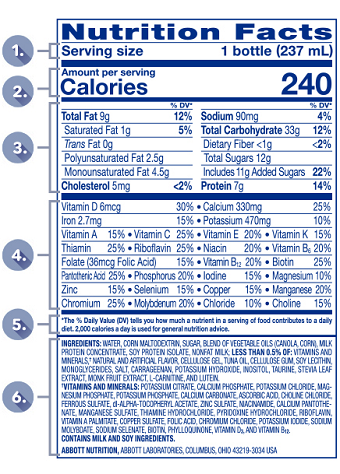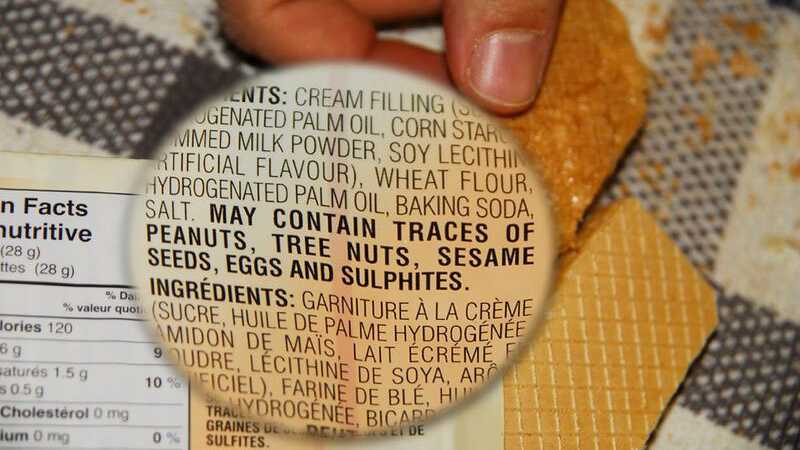41 understanding ingredients on food labels
how to understand food labels - Eat For Health Food with less than 400mg per 100g are good, and less than 120mg per 100g is best. Ingredients Listed from greatest to smallest by weight. Use this to check the first three ingredients for items high in saturated fat, sodium (salt) or added sugar. Other names for ingredients high in saturated fat: Animal fat/oil, beef fat, How to understand food labels | Eat For Health The Nutrition Information Panel on a food label offers the simplest and easiest way to choose foods with less saturated fat, salt (sodium), added sugars and kilojoules, and more fibre. It can also be used to decide how large one serve of a food group choice or discretionary food would be and whether it's worth the kilojoules.
Labels - Understanding ingredient labels - Center for Research on ... Cosmetic labels provide an overview of what the product does, the ingredients in the product, and any allergens (e.g., nut oils, etc.). Food labels will have the ingredient list under the " Nutrition Facts " heading to provide vital nutrient information for the product. It will also list allergen information.
/-15_-_ITALY_-_DOCG_and_DOC_wine_mark-56d456215f9b5879cc8fa76f.jpg)
Understanding ingredients on food labels
Overview of Food Ingredients, Additives & Colors | FDA The Food and Drug Administration (FDA) maintains a list of over 3000 ingredients in its data base "Everything Added to Food in the United States", many of which we use at home every day (e.g ... Easy Tips To Understand The Ingredient List On Food Labels Sugar, sodium and saturated and trans fats have a myriad of monikers. Sugar, for example, may appear as sugar, high fructose corn syrup, agave nectar, brown rice syrup, honey, molasses and a slew of words that end in "ose" (think glucose, fructose, maltose and galactose). Worried about sodium? Understanding food labelling and decoding nutrition Labels Food labels will include information like manufacture date, 'use by' date, cost of the packet, list of ingredients, instructions of use, quality and nutritional value to promote the sale of ...
Understanding ingredients on food labels. Understanding Food Nutrition Labels | American Heart Association When the Nutrition Facts label says a food contains "0 g" of trans fat, but includes "partially hydrogenated oil" in the ingredient list, it means the food contains some trans fat, but less than 0.5 grams per serving. So, if you eat more than one serving, you could end up eating too much trans fat. Understanding Food Labels and Ingredient Lists: FAQs and Do's ... - AFPA Fresh eggs. Foods with insignificant amounts of the nutrients on the required label, such as coffee, tea, spices, flavor extracts, and food colors. These may contain ingredient labels but are unlikely to contain nutrition facts labels. Packaged single-ingredient meat products, such as deer, bison, rabbit, quail, wild turkey, and ostrich. 2.6: Understanding Food Labels - Medicine LibreTexts Ingredients, listed in descending order by weight (the first product on the list is the predominant ingredient in that food) must also clearly state presence of any common food allergens (peanuts, tree nuts, milk, wheat, eggs, soy, fish, shellfish) Nutrition information (also known as the Nutrition Facts label) How To Read Food and Beverage Labels - National Institute on Aging Feb 24, 2022 · Sometimes, food and beverage packaging includes terms that may try to convince the consumer the food is healthy. To help avoid confusion, the FDA sets specific rules for what food manufacturers can call “light,” “low,” “reduced,” “free,” and other terms. This type of labeling may have little to do with how nutritious the food is.
Understanding Dog Food Labels The ingredients on a dog food label are listed from the highest amount of the ingredient to the lowest amount. Ensure that the food has real meat listed as the first ingredient, such as "salmon" or "chicken." The next ingredient on the dog food label should be a meat meal, such as "chicken meal." Understanding Food Labels - The Nutrition Source Under the Food Allergen Labeling and Consumer Protection Act of 2004, eight major food allergens—milk, fish, tree nuts, peanuts, shellfish, wheat, eggs, and soybeans—are required to be listed in a "contains" statement near the Ingredients list if present in a food. An example would be "contains wheat, milk, and soy." Understanding Food Nutrition Labels - American Heart Association When the Nutrition Facts label says a food contains "0 g" of trans fat, but includes "partially hydrogenated oil" in the ingredient list, it means the food contains some trans fat, but less than 0.5 grams per serving. So, if you eat more than one serving, you could end up eating too much trans fat. How to read food labels | healthdirect In Australia, the law requires all manufactured foods to carry labels containing safety and nutrition information. This information helps you to make decisions about the food you buy and eat so you can follow a healthy diet. The label will tell you: the name of the product, describing accurately what it is. the brand name.
Understanding Ingredients on Food Labels - American Heart Association Mar 06, 2017 · Understanding Ingredients on Food Labels. Food labels are an important source of information about calories and the nutritional value of the foods you eat, a crucial tool in building a heart-healthy diet. Understanding food labels - Canada.ca Find information on food labels and how to understand them. Learn about nutrition facts tables, serving size, list of ingredients, % daily value and nutrition claims. Sunscreen: How to Help Protect Your Skin from the Sun | FDA - U.S. Food … Nov 08, 2021 · The labels are required to state whether the sunscreen remains effective for 40 minutes or 80 minutes when swimming or sweating, and all sunscreens must provide directions on when to reapply ... Understanding Food Labels - Food Allergy Research & Education food labels? No. The only foods that have to be declared are those the FDA considers major food allergens: milk, wheat, egg, peanuts, tree nuts, fish, crustacean shellfish, and soy, or ingredients that contain proteins from these foods. Do major food allergens contained in dyes (food coloring), spices, flavorings, additives and processing
How To Read Food and Beverage Labels - National Institute on Aging Understanding food and beverage product dates There are three types of product dates commonly printed on packaged foods and beverages: "Sell by" tells how long the manufacturer suggests that a store should sell items such as meat, poultry, eggs, or milk products. Make sure you buy by this date. "Use by" tells how long items will be at peak quality.
How to Read Food Labels Without Being Tricked - Healthline If the first ingredients include refined grains, a type of sugar, or hydrogenated oils, you can assume that the product is unhealthy. Instead, try choosing items that have whole foods listed as the...
Understanding Food Labels - Food Ingredient Facts Food labels are required to list all ingredients contained in the food in descending order based on the amount found in the final product. Most food additives are therefore found toward the end of the ingredient list. This indicates they are used in very small amounts in the food, generally less than two percent of the product.
Understanding food labels | Diabetes UK It’s important to check the ingredients list or back of pack label so you can compare two products like for like per 100g. Six ways to be label savvy. Follow these tips to become expert at understanding labels in minutes: With traffic light labels, go for green, occasionally amber, and red only as a treat.
Understanding Ingredients on Food Labels - American Heart Association There are many terms used for sugar on food labels. You might see sugar listed as the fourth ingredient in a product and think it's not so bad. But sugar can also be listed as high-fructose corn syrup or corn syrup, agave nectar, barley malt syrup or dehydrated cane juice, to name just a few. Read more about sugar and sweeteners.
Understanding Ingredients In Food Labels | Eufic The quantity of a product's main or characterising ingredients must be declared, usually as a percentage, when the ingredient (or category of ingredient) appears in the name of the food, is normally associated with that food, or is given particular emphasis in the label (e.g. highlighted or pictured). Explaining ingredients
Understanding Food Nutrition Labels | American Stroke Association The U.S. Food and Drug Administration (FDA) regulates the Nutrition Facts label seen on packaged foods and drinks. In 2016, the FDA released changes to the label to make it easier to see how many calories and added sugars are in a product and to make serving sizes more realistic. These changes are still being implemented throughout the food ...




Post a Comment for "41 understanding ingredients on food labels"